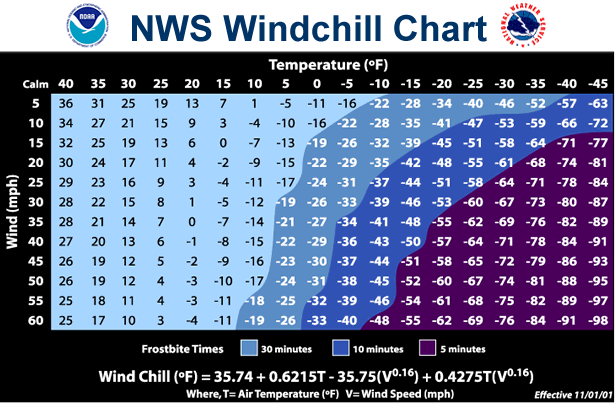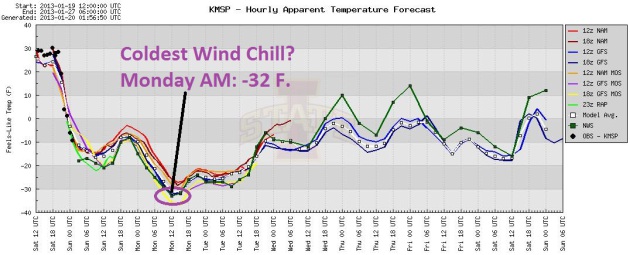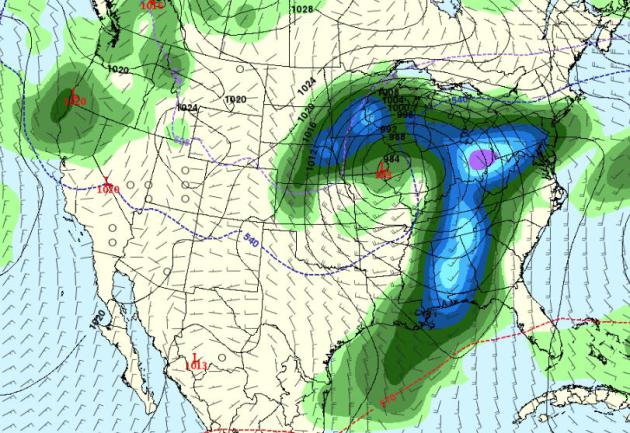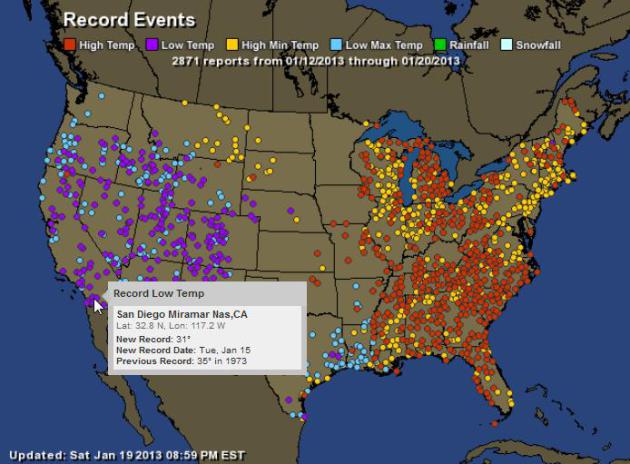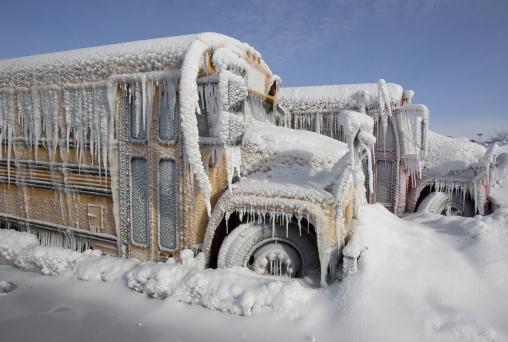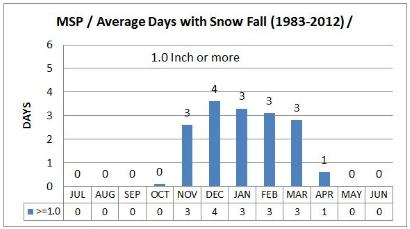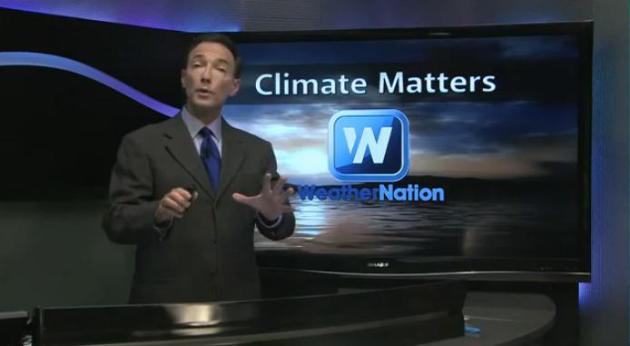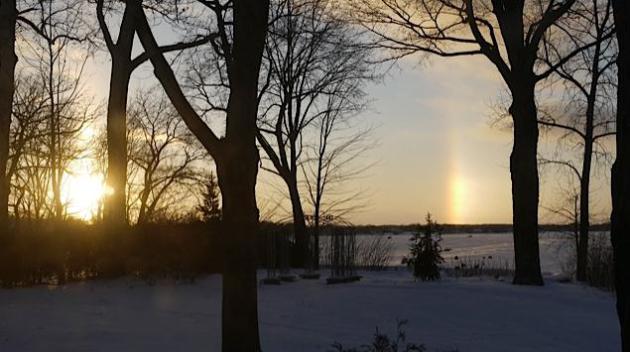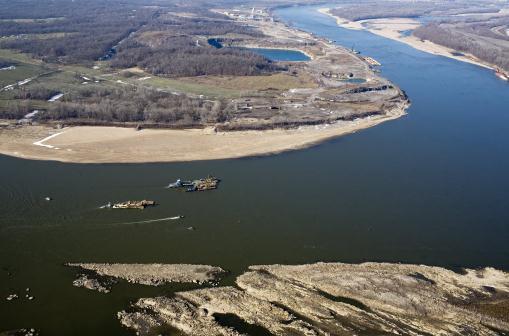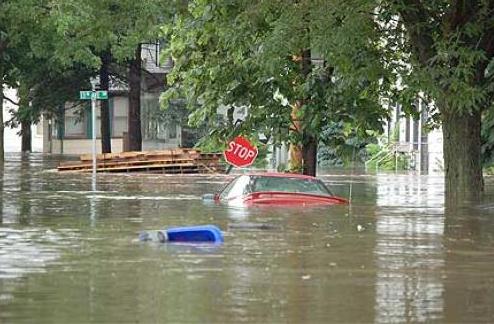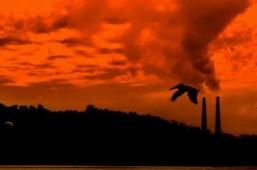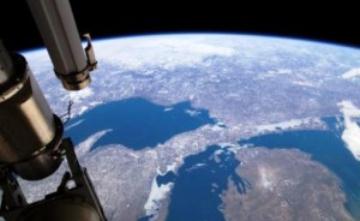Fresh Air!
Chilly. Cold. Bitter. Polar. "It only hurts when
I breathe" a friend snorted. "This is why bears hibernate" another
shrugged. Look at the bright side: when it's this Nanook the crime rate
plummets. And your garbage doesn't stink.
What baffles me every January: how did our
great, great, GREAT grandparents survive a Minnesota winter - before
central heating, cable and heated car seats? We were settled by a
supernaturally-hardy species of supermen and superwomen.
No need to take that Yukon vacation; a taste of
the Great White North is coming to you. Subzero temperatures are likely
from tonight into midday Tuesday; 36-48 hours of negative numbers.
Monday wind chills dip to -35 in the metro, -45 up north.
It would be even colder if not for brown ground
and a lack of snow, which acts as an insulator. If you've had problems
with frozen pipes in years past you'll want to pay attention.
Inspect your kids before sending them off to the
bus stop Monday. The "no exposed skin" rule is in full effect. In my
case it's in effect pretty much yearround.
Welcome to the coldest week of winter; a coating of snow Thursday - a thaw returns a week from tomorrow.
Historically, January is the coldest, snowiest month of the year. OK, we're batting .500.
Windchill Watch. Underscoring
how dangerous the current and predicted chill factors will be, here's
the latest from the Twin Cities National Weather Service:
URGENT - WINTER WEATHER MESSAGE
NATIONAL WEATHER SERVICE TWIN CITIES/CHANHASSEN MN
811 PM CST SAT JAN 19 2013
...LOW WIND CHILLS TONIGHT...BUT DANGEROUS WIND CHILLS POSSIBLE
SUNDAY NIGHT INTO MONDAY...
.THE COMBINATION OF GUSTY NORTHWEST WINDS AND TEMPERATURES
DROPPING INTO THE SINGLE DIGITS BELOW ZERO WILL CAUSE HAZARDOUS
WIND CHILLS AROUND 25 BELOW OVER PORTIONS OF CENTRAL MINNESOTA
INTO WEST CENTRAL WISCONSIN LATE TONIGHT INTO SUNDAY MORNING.
ANOTHER ARCTIC FRONT WILL SURGE SOUTHEAST SUNDAY WITH EVEN COLDER
AIR ARRIVING SUNDAY EVENING. LOW TEMPERATURES SUNDAY NIGHT WILL
RANGE FROM 10 TO 15 BELOW NEAR THE IOWA BORDER...TO 20 TO 25
BELOW ACROSS CENTRAL MINNESOTA. THESE BITTERLY COLD TEMPERATURES
COMBINED WITH A NORTHWEST WIND OF 10 TO 15 MPH WILL CREATE WIND
CHILLS OF 35 TO 45 BELOW ZERO THROUGH MONDAY MORNING...WITH THE
COLDEST READINGS OVER CENTRAL MINNESOTA.
ONLY A SLIGHT MODERATION OF TEMPERATURES IS EXPECTED DURING THE
DAY MONDAY WITH HIGHS EXPECTED TO RANGE FROM 1 BELOW TO 11 BELOW.
ANOTHER BITTERLY COLD NIGHT IS ANTICIPATED MONDAY NIGHT WITH LOWS
OF 12 TO 25 BELOW BUT LIGHTER WINDS LEAVE ENOUGH UNCERTAINTY OF SUB
35 BELOW WIND CHILLS FOR A WIND CHILL WATCH AT THIS TIME.
...WIND CHILL ADVISORY REMAINS IN EFFECT UNTIL 11 AM CST SUNDAY...
...WIND CHILL WATCH IN EFFECT FROM SUNDAY EVENING THROUGH MONDAY
AFTERNOON...
THE NATIONAL WEATHER SERVICE IN TWIN CITIES/CHANHASSEN HAS ISSUED
A WIND CHILL WATCH...WHICH IS IN EFFECT FROM SUNDAY EVENING
THROUGH MONDAY AFTERNOON.
* WIND CHILL VALUES...AROUND 25 BELOW TONIGHT AND SUNDAY
MORNING...AND AROUND 45 BELOW SUNDAY NIGHT AND MONDAY MORNING.
PRECAUTIONARY/PREPAREDNESS ACTIONS...
A WIND CHILL ADVISORY MEANS THAT VERY COLD AIR AND STRONG WINDS
WILL COMBINE TO GENERATE LOW WIND CHILLS. THIS WILL RESULT IN
FROST BITE AND LEAD TO HYPOTHERMIA IF PRECAUTIONS ARE NOT TAKEN.
IF YOU MUST VENTURE OUTDOORS...MAKE SURE YOU WEAR A HAT AND
GLOVES.
A WIND CHILL WATCH MEANS THERE IS THE POTENTIAL FOR A COMBINATION
OF VERY COLD AIR AND STRONG WINDS TO CREATE DANGEROUSLY LOW WIND
CHILL VALUES. MONITOR THE LATEST FORECASTS AND WARNINGS FOR
UPDATES ON THIS SITUATION.

Coldest Week Of Winter. If there was any doubt in my
mind (or yours), this graphic should erase it altogether. I expect
40-44 hours of air temperatures below zero, from this evening thru
midday Tuesday; highs Tuesday will barely rise above zero. A reinforcing
shot of cold air arrives late in the week, subzero again Saturday
morning before we finally pull out of the Deep Freeze.
Serious Wind Chills. We've heard the drills
(although not so much in recent years). Multiple layers, no exposed
skin, warm hat (covering the ears). Warm footwear. Make sure your kids
(or lazy spouse) dresses for the elements, especially Monday morning,
when wind chills in the metro reach their lowest values; around -30 to
-32 F. Exposed skin can become frostbitten in less than 5 minutes.
Fun With Negative Numbers. The ECMWF predicted highs
above are in Celsius, showing the coldest temperatures Monday and
Tuesday, another slug of bitter air by the end of the week. No
significant snow is on tap (too cold - the storm track has been shoved
way south). A coating is possible Thursday and Friday, little more.
Late January Snowstorm? It's way too early to get
excited, but the GFS model spins up an impressive storm over the Upper
Midwest around January 30th, a Wednesday. Please circle your calendar.
I'm skeptical ("when in a drought don't predict rain....or snow") but in
the spirit of full disclosure, computer model warts and all, here goes.
Place your bets.
What A Week. 2,871 temperature records, nationwide,
in the span of a week. Record warmth east of the Mississippi, record
chill west of the Rockies, and now the coldest air of winter is pushing
south out of Canada. For an interactive map from Ham Weather showing
details for each (dot)
click here.
Absence Of Below Zero F. High Temperatures. In this week's
Weathertalk Newsletter
Dr. Mark Seeley has a good summary of the streak of above zero daytime
highs here in the Twin Cities, but the warm bias is even showing up in
the city famous for (among other things) testing car batteries,
International Falls: "...
For Twin Cities residents we may be seeing a
remarkable record weather streak come to an end by Martin Luther King
Day (Monday, Jan 21st). The Twin Cities have not reported a daytime
high temperature below 0 F since January 15, 2009 (high of -6 F). By
Monday, this streak will be 1466 days long, the longest such streak in
the Twin Cities climate record back to 1873. In addition the National
Weather Service reports a remarkable absence of below 0 F minimum
temperatures for the Twin Cities in recent winters as well, with only 3
such days last winter, and 1 so far this winter. This trend, but to a
lesser extent is obvious in the recent data for International Falls as
well. There the average number of days when the high temperature
remains below 0 F is about 10 per winter. Over the past three winters
it has just been 3 days. In addition, overnight minimum temperatures
at International Falls fall below 0 F slightly 60-61 days per winter on
average. Last winter brought only 35 such days, and there have been
only 26 such days so far this winter, well below average...
File photo above: AP. The local NWS office has more on our streak of days with daytime highs above zero
here.
Days With One Inch Or More In The Twin Cities. So
far this winter the Twin Cities have experienced 3 days with 1" or more
of snow falling in a 24 hour period. As you can see from the graph above
the Twin Cities pick up an average of 17 days/winter season with 1" or
more of snow, on average. Oh, to be average again. Graph courtesy of the
Twin Cities National Weather Service.
Primetime Wintertime. It's a bit strange to be
getting intense cold - without the snow. If you're looking for serious
snowfall amounts fly to London, or Paris, or the south of France.
Details on the latest installment video of
Climate Matters: "
As
the Midwest prepares for an arctic blast, snow is crippling travel in
other parts of the world. Meteorologist Paul Douglas looks at some of
the global temperature extremes and winter conditions around the globe."
Equation Of Time Solves Problem Of Gray Mornings. As of today sunset is
30 minutes later than it was on December 21, yet sunrise is only
3 minutes earlier. Why isn't it equal? This is a question I get often, and (sadly) there is no easy answer, but this
New York Times article does the best job I've ever seen explaining the disconnect; here's an excerpt: "...
Earth’s
tilt means that every day during the fall, the angle at which we view
the Sun changes. It appears farther south and travels a shorter arc
across the sky, affecting sunrise and sunset equally, and making the
day shorter. The changes in the solar time follow a different cycle. In
the early 1600s, Kepler
discovered that planets move faster at the part of their orbit that is
closest to the sun, the perihelion. For Earth, perihelion comes a
little after the winter solstice, so from November on, Earth is
accelerating. That increased speed means we reach the Sun’s maximum a
little earlier each day, which pushes solar noon backward against clock
time. That shift is amplified because the Sun is traveling a little
south each day, while clocks only count its east to west traverse. Add
it all together and you get sunrise and sunset times that are not
symmetrical..."
What's Causing Australia's Heat Wave? Here's an excerpt of a fascinating article at Australia's
The Conversation, focusing on the factors converging to create historic heat across the country: "...
And
it’s not like these sorts of days occur that often. The records set
last week sit between two and three standard deviations above the
long-term January mean of 35°C. Perhaps more unusually, the Australian
mean temperature (representing the average of the daytime maximum and
night-time minimum) set record high values on both days at 32.22
(January 7) and 32.32°C (January 8), that were well above the previous
high of 31.86°C, set in 1972. However, it is really the duration of this
extreme heat wave that makes it so unusual, and so significant in terms
of impacts..."
Graphic credit above: "Highest daily maximum temperature during the first two weeks of January." Australian Bureau of Meteorology.
Keeping The Boats Moving Along A Mississippi Dwindled By Drought.
Things look a little better for navigation on the Mississippi, but
officials are still concerned about 2013 conditions, with drought
conditions upstream.
The New York Times has the story; here's an excerpt" "...
The
fact that the river has remained open for business along the critical
“Middle Miss” — the 200 miles between the Mississippi’s last
dam-and-locks structure, above St. Louis, down to Cairo, Ill., where the
plentiful Ohio River flows in — stems from a remarkable feat of
engineering that involved months of nonstop dredging, blasting and scraping away of rock obstructions
along the riverbed, effectively lowering the bottom of the channel by
two feet. It has also involved exacting use of reservoirs along the
vast river system that were initially designed by engineers using slide
rules nearly 100 years ago to try to manage both flood and drought, as
well as rock structures placed in recent years along the bank to
direct water and speed it up, a bit like a thumb over the end of a
garden hose..."
Photo credit above: "Barges work on
dredging the Mississippi River near Thebes, Ill., Jan. 8, 2013. Despite
withering drought that has caused record-breaking low water levels
that threaten to shut down traffic on the Mississippi River, it remains
open for business thanks to an engineering feat that lowered the
bottom of the channel by two feet." (Tyler Bissmeyer/The New York Times)
"Hurricane Hunters" Kept Relentless Watch On 2012 Storms.
Did you know that the Air Force flies their planes into (major) winter
storms, to gather more accurate data for NOAA's computer models? Here's
an excerpt of an article from the U.S. Air Force: "As
the nation rebounds from 19 named storms and 11 major hurricanes in
2012, a small but hardy military organization keeps relentless watch to
track and prepare for such disasters. Located at Keesler Air Force
Base, Miss., the 53rd Weather Reconnaissance Squadron, dubbed the
"Hurricane Hunters" of the Air Force Reserve, is the Defense
Department's sole organization dedicated to flying into tropical storms
and hurricanes. The unit has performed the mission since 1944. In a
"DOD Live" bloggers roundtable today, Lt. Col. Jon Talbot, 53rd WRS
chief meteorologist, and Capt. John Brady, a meteorologist with the
squadron, said collecting winter storm, hurricane and tropical cyclone
data for the National Weather Service is critical in mitigating loss of
life and property. Typically, a winter storm mission begins only if the
weather system will have a large, societal impact somewhere in the
United States, Talbot explained. "Winter storms kill more people than hurricanes do,"
Talbot said, noting his team's specialty in analyzing data over water,
where information is sparse. "If the National Weather Service is
seeing a lot of uncertainty in their [data], they'll contact our
liaison team."
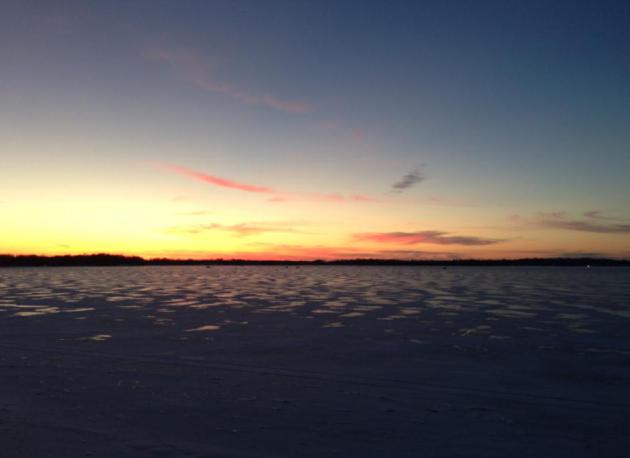
Climate Stories....
Heatwave, Storms, Flooding: Climate Change To Profoundly Affect U.S. Midwest In Coming Decades. Here's the intro to a story at
Science Digest: "
In
the coming decades, climate change will lead to more frequent and more
intense Midwest heat waves while degrading air and water quality and
threatening public health. Intense rainstorms and floods will become
more common, and existing risks to the Great Lakes will be exacerbated.
Those are some of the conclusions contained in the Midwest chapter of a
draft report released last week by the federal government that
assesses the key impacts of climate change on every region in the
country and analyzes its likely effects on human health, water, energy,
transportation, agriculture, forests, ecosystems and biodiversity..."
Photo credit above: "A flooded urban street". (Credit: Don Becker, USGS)
Regardless Of Why, Climate Change Will Be Changing US In S.D. Here's an excerpt of an article at
The Rapid City Journal that got my attention: "...
Earlier
this month, the U.S. Global Change Research Program issued the latest
version of the national climate assessment. You can find it online at globalchange.gov.....The five key messages in the Great Plains chapter discuss:
- Demand for water and energy increasing because of rising temperatures;
- Warmer winters and changes in timing and magnitude of
rainfall events are altering crop growth cycles, and new agriculture
and livestock management approaches will be necessary;
- Species are finding more difficulty in adapting because of landscape fragmentation, including from energy development;
- Communities already stressed by weather and climate extremes will face more frequent extreme events;
- The changes will exceed what was experienced in the past century..."
Watch 62 Years Of Global Warming In 13 Seconds. Climate Central has the remarkable
YouTube video clip, courtesy of NASA.
Global Warming Brings Earlier Spring Flowers. Here's an excerpt of a story at
Discovery.com: "...
They
found that as temperatures warmed over the last 161 years, the date of
first blooms of the season crept forward, too — about 10 days earlier
than when Thoreau first visited the site. During the record-breaking
years of 2010 and 2012, flowering happened a full 20 to 21 days
earlier. The average spring temperature at Walden Pond has increased
about 6 degrees Fahrenheit (3.4 degrees Celsius) since Thoreau's time..."
Photo credit above: "In incredibly detailed notebooks, Thoreau documented the flowering times of species such as the wild columbine." TBoard | Flickr.com.
How Climate Change Is Damaging The Great Lakes, With Implications For The Environment And The Economy. The Center for American Progress and
Think Progress have the story; here's an excerpt: "
Great Lakes Michigan and Huron set a new record low water level for the month of December, and in the coming weeks they could experience their lowest water levels ever.
It’s becoming certain that, like the rest of the country, the Great
Lakes are feeling the effects of climate change. Last year was
officially the warmest year
on record for the lower-48 states. The hot summer air has been causing
the surface water of the Great Lakes to increase in temperature. One
might think this causes more precipitation around the lakes, but the
warmer winter air is causing a shorter duration of ice cover. In fact,
the amount of ice covering the lakes has declined about 71 percent over the past 40 years. Last year, only 5 percent of the lakes froze over –- compared to 1979 when ice coverage was as much as 94 percent...."

